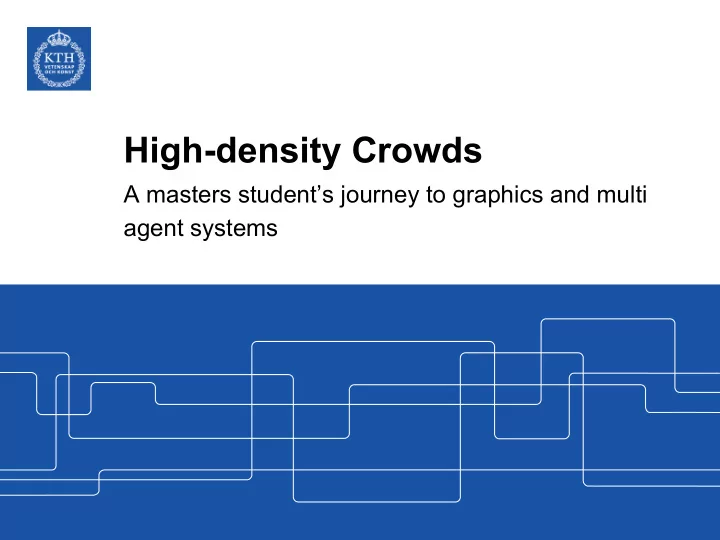

High-density Crowds A masters student’s journey to graphics and multi agent systems
Who am I and why am I here? Jack Shabo, student of CDATE, year 2012 Doing a degree project in Crowd Simulations with Christopher Peters as a mentor Has taken previous year’s round of Computer Graphics and Interaction Many other graphics courses + I’d like to share with you my experiences and give you inspiration for your projects!
Layout What I’ve been doing previously 1. What I’ve been doing recently 2. Where I’m going next 3. Where you can go next 4.
New at KTH!
DD1354 - Models and Simulation My very first course with computer graphics - Unity & Blender -
DH2323 - Computer Graphics and Interaction Project result: Helicopter simulation with (somewhat) real physics and joy-stick interaction
DH2413- Advanced Computer Graphics and Interaction Use more technologies: Virtual Reality (HTC VIVE, Oculus..), Augmented Reality (Mobile phones, infra-red sensors..) Expand your knowledge of modern technologies and make something really outstanding. Take the “interaction” part more into consideration. Exhibit at COMIC CON ←
DH2413 - Comic con
DH2413 - Comic Con
Now: The master thesis “High-Density Crowd Simulation with subgroups” → Multi-agent system with controllable people Suggested by Christopher Peters But.. why crowds? Architectural plans - Optimizing pedestrian walkways - Evacuation plans - Social behavior - . . . -
... a HUGE area with LOTS of components Path Finding - Rendering optimizations - Real-life emulation - Collision Detection - Collision Response - And then my focus area: Collision Avoidance - - Using a fluid based approach to simulate 1000+ crowd agents in real time - Most crowd simulations can’t simulate this in real time → Hardware restriction
Example: Planet Coaster
Example: High Density Crowd Assassins Creed Unity
The “Unilateral Incompressibility Constraint” approach Problem: How do you keep crowd agents apart from each other? (Collision avoidance) Observations: Crowds are infinitely expandable, but not infinitely - compressible. People want to keep a certain distance from each other - Dense crowds has a reduced individual freedom of - movement People often walks in groups (My investigation) -
Crowd properties A crowd consist of many distinct individuals that each have a position, velocity and goal. Position: World space location Velocity: Speed determining how fast and where the individual is going. Goal: A point in space that the individual will steer towards. General locations: (Restaurant, School, Home) - Specific (partial) locations: (The bus station 200m - ahead, Out of the shopping mall)
The “Unilateral Incompressibility Constraint” approach Problem: How do you keep crowd agents apart from each other? (Collision avoidance) Solution: Do not consider the crowd as distinct agents. Instead, transform them into a continuous representation with: Density values at certain positions - Velocity laid out on a large “velocity field” - Unilateral approach: Introduce a “pressure” that corrects the crowd’s velocity when the density is too high. Feedback the corrected velocity to the distinct agents.
The “Unilateral Incompressibility Constraint” approach Source (2017-04-22): http://gamma.cs.unc.edu/DenseCrowds/
Components of the simulation
Global Planner
Staggered Grid
LCP Problem (Numerical Method solver)
Rendering agents High Poly Model Low Poly Model
Demo video from my system
Technologies used C# for scripting and making most of the work Unity as a game engine Blender for 3D models / Animations (Mostly purchased)
So what am I going to do next? Continue to write a report.. Integrate evaluation methods.. Come up with scenarios.. ..perform a User Study ← You
User Study ● Detect subgroups in crowds of various densities. ● Sometime in the beginning of May (VIC Studio) ● Not very long - 15 minutes tops.
How can YOU use my project in DH2323? Project opportunities in DH2323 Improved pathfinding (Hand drawn paths?) - Rendering with shaders on the GPU - Render 3D models with smooth shading - Extend simulation with moving obstacles - See through the crowd’s eyes using Virtual Reality - Define better subgroups - … - Your own suggestion! -
Thank you! Jack Shabo jshabo@kth.se Blog: https://crowdsimulationblog.wordpress.com/
Recommend
More recommend